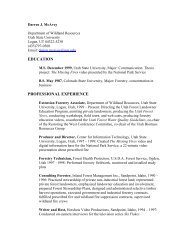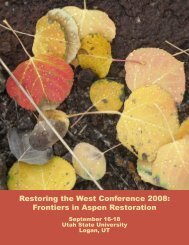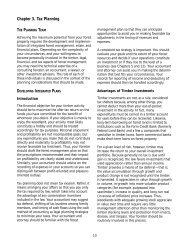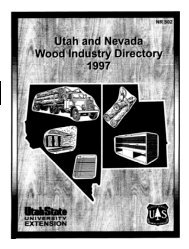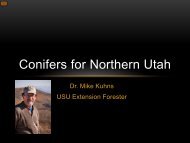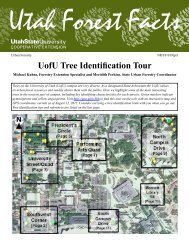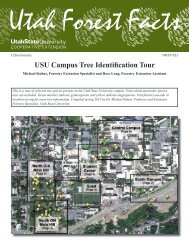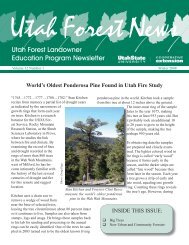A Technical Manual for Landowners, Loggers, and ... - Forestry
A Technical Manual for Landowners, Loggers, and ... - Forestry
A Technical Manual for Landowners, Loggers, and ... - Forestry
Create successful ePaper yourself
Turn your PDF publications into a flip-book with our unique Google optimized e-Paper software.
R O A D S, S K I D T R A I LS , L A N D I NG S<br />
& S T R E A M C R O S S I NG S<br />
R O A D S, S K I D T R A I L S ,<br />
L A N D I NG S & S T R E A M C R O S S I NG S<br />
Roads, skid trails, l<strong>and</strong>ings <strong>and</strong> stream crossings make up a <strong>for</strong>est transport a t i o n<br />
system. Poorly located, constructed, or maintained <strong>for</strong>est roads are the largest<br />
source of non-point source pollution from <strong>for</strong>est management activities. Roads<br />
on steep slopes, erodible soils or stream crossings hold the greatest potential<br />
<strong>for</strong> degrading water quality. Research has shown that 90 percent of the sediment<br />
that ends up in our Nation’s waters is a result of improper roads.<br />
P l a n n i n g<br />
Soil erosion is a primary cause of stream sedimentation associated with<br />
<strong>for</strong>est roads. Mass movement associated with road construction also causes<br />
sedimentation. Careful <strong>for</strong>est road planning, construction <strong>and</strong> maintenance<br />
protects the water quality of our lakes <strong>and</strong> streams. Decisions made during<br />
the planning stage will affect road construction costs, maintenance needs,<br />
service life <strong>and</strong> the amount of non-point source pollution related to roads.<br />
Recommended Practice St<strong>and</strong>ards <strong>and</strong> Guidelines<br />
■ Use the minimum number of roads to meet transportation needs. Plan<br />
road systems that minimize the number, width <strong>and</strong> length of roads to<br />
limit disturbance of the area.<br />
■ If possible, locate roads outside Streamside Management Zones (see<br />
Chapter 3: Streamside Management Zone)<br />
■ Design roads <strong>for</strong> safety, their intended purpose <strong>and</strong> to fit the natural terrain.<br />
■ If possible, locate <strong>and</strong> construct road surfaces to drain naturally away<br />
from the road.<br />
■ Plan <strong>for</strong> drainage features to be placed at suitable locations.<br />
■ Minimize the number of stream crossings. Use stream crossings only<br />
when necessary.<br />
■ Keep road grades below 10% wherever possible <strong>and</strong> avoid sustained<br />
excessive grades (greater than 10%).<br />
Road Const ru c t i o n<br />
The most critical issue regarding road construction is drainage of surface<br />
water from the road surface. Tr a ffic causes ruts when st<strong>and</strong>ing water is pre s e n t .<br />
Running water erodes the road surface <strong>and</strong> deposits the sediment in streams<br />
<strong>and</strong> lakes.<br />
Recommended Practice St<strong>and</strong>ards <strong>and</strong> Guidelines<br />
■ Become familiar with the terrain by using topographic maps or aerial<br />
photographs <strong>and</strong> repeatedly walking the proposed road location. Use<br />
flagging to designate the road location.<br />
■ Avoid construction activities when ground is wet or frozen.<br />
■ Install road drainage at time of construction.<br />
■ Compact all road fill material. Do not use snow, ice, frozen soil or<br />
woody debris as these will eventually melt or rot, causing voids that<br />
lead to road failure.<br />
■ Maintain live trees or slash rows at the base of fill slopes to filter sediments.<br />
■ Avoid constructing berms that may channel water down road.<br />
■ Reseed disturbed areas as soon as practical.<br />
14 page<br />
page 15



